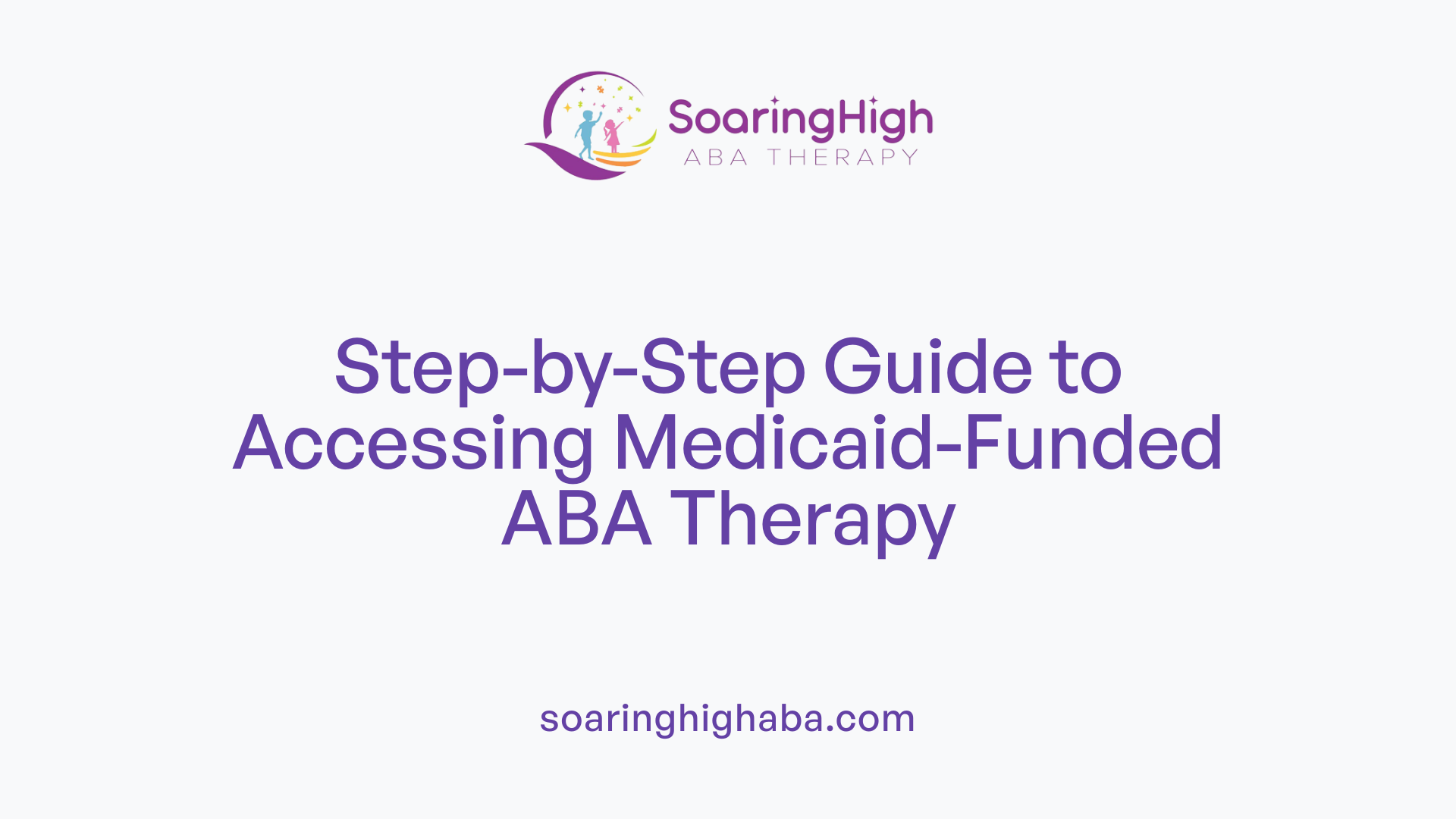Understanding Medicaid Coverage for ABA Therapy
Medicaid plays a crucial role in providing access to Applied Behavior Analysis (ABA) therapy, a proven and evidence-based intervention for children on the autism spectrum. As of 2022, all fifty states have integrated coverage for ABA therapy into their Medicaid programs, expanding access and reducing financial barriers for families. This article offers a comprehensive guide to understanding the scope, legal framework, application processes, and resources available for Medicaid-funded ABA services, empowering families and caregivers to navigate the system effectively.
Legal Foundations and Federal Mandates Supporting ABA Coverage

What are the federal and state laws governing Medicaid coverage for autism treatments?
The landscape of Medicaid coverage for autism treatments, including Applied Behavior Analysis (ABA), is shaped by a combination of federal and state laws. Federal frameworks like the Americans with Disabilities Act (ADA) and Medicaid requirements establish foundational protections and obligations.
A cornerstone federal mandate is the Early and Periodic Screening, Diagnostic, and Treatment (EPSDT) benefit introduced in 1967. This provision mandates Medicaid to cover medically necessary services for children under 21, including autism-related interventions such as ABA therapy. CMS (Centers for Medicare & Medicaid Services) provides guidance and informational resources emphasizing that autism treatments should be covered under EPSDT. These federal directives compel states to ensure access to comprehensive autism services, fostering early diagnosis, intervention, and ongoing support.
Alongside federal directives, state laws significantly influence the scope of Medicaid autism coverage. Many states have enacted statutes that specify minimum benefits, age limits, service caps, and whether specific therapies, including ABA, must be covered. Some states have comprehensive mandates requiring coverage for children and even adults, while others set limitations or carve-outs for certain services.
State regulations often align with federal standards but can also introduce restrictions or enhancements. Fully insured and state-regulated health plans are also governed by these state laws, which can provide additional protections or impose restrictions.
The Legal context includes the influence of the Mental Health Parity and Addiction Equity Act (MHPAEA). This law prevents health plans from imposing more restrictive coverage limitations on mental health services like ABA compared to physical health treatments. As a result, restrictions such as dollar caps or treatment hour limits cannot be more stringent for mental health services.
In summary, federal laws like EPSDT lay the groundwork for coverage, requiring states to provide necessary autism-related treatments. However, the actual scope and details largely depend on state-specific laws and regulations, creating a patchwork landscape across the United States. Families and providers must navigate both federal standards and state policies to understand the coverage options available.
Role of EPSDT in Medicaid autism treatment
The EPSDT program plays a pivotal role in ensuring children with autism have access to needed behavioral health services, including ABA therapy. It mandates that states offer a comprehensive array of screening and treatment services, with a focus on early intervention.
Once a child receives a formal diagnosis of Autism Spectrum Disorder (ASD) from a qualified healthcare professional, EPSDT requires Medicaid to cover all medically necessary services to improve the child's development and functioning. This includes evidence-based therapies like ABA, speech, occupational, and physical therapies.
To access these services, documentation demonstrating medical necessity—such as diagnostic evaluations, detailed treatment plans, and progress notes—is essential. This evidence supports the claim that ABA would alleviate or manage autism symptoms, fulfilling the requirement that treatments be medically necessary.
States are obligated to provide services in the least restrictive environment, aligning with the Olmstead v. L.C. Supreme Court decision, which advocates for integration and community-based care whenever possible.
Coverage is automatic for all Medicaid-eligible children under 21, emphasizing early intervention. Families typically need to work with providers to obtain referrals, submit documentation, and navigate the pre-authorization process.
Impact of the Mental Health Parity and Addiction Equity Act
The MHPAEA, enacted in 2008, significantly affects the coverage of autism treatments like ABA by requiring parity between mental health and physical health benefits.
Prior to MHPAEA, mental health services often faced more restrictions, such as lower service caps or limited coverage hours. This law prohibits health plans from imposing more restrictive limitations on mental health services, including ABA, compared to any medical or surgical benefits.
As a result, restrictions such as dollar limits, visit caps, or age restrictions that are more restrictive for mental health are not permissible unless they are equally applied to physical health services.
This legislative safeguard aims to improve access and reduce disparities for individuals needing mental health interventions, including those with autism. However, coverage specifics can still vary depending on individual insurance plans and state regulations.
In conclusion, federal laws like EPSDT and MHPAEA, alongside state statutes, create a comprehensive legal foundation for Medicaid coverage of autism treatments. These policies aim to promote access, ensure treatment quality, and uphold the rights of individuals with autism to necessary behavioral health services.
Medicaid’s Role in Autism and ABA Therapy Coverage

What is Medicaid coverage for ABA therapy services?
Medicaid plays a crucial role in providing access to autism-related treatments, including applied behavior analysis (ABA) therapy. The scope of coverage can differ depending on state policies; however, federal mandates generally require Medicaid programs to support treatments for autism spectrum disorder (ASD). A central part of this support is the Early and Periodic Screening, Diagnostic, and Treatment (EPSDT) benefit, introduced in 1967, which obligates Medicaid to cover medically necessary preventative and treatment services for children under 21.
Most states have adopted specific mandates or policies that require Medicaid to cover ABA therapy as part of their autism treatment services. These services include comprehensive assessments, developing individualized treatment plans, and ongoing behavioral therapies aimed at improving symptoms associated with autism. Coverage often encompasses various components such as initial evaluations, behavioral interventions, and sometimes related therapies like speech, occupational, or physical therapy.
Although federal regulations set the framework, the implementation of Medicaid autism coverage can vary widely from state to state. Some states have broad policies that fully embrace ABA coverage, while others may impose restrictions such as caps on service hours or age limits. Nonetheless, as of 2022, all 50 states have generally expanded access to Medicaid-funded ABA services for eligible children, driven by both federal mandates and state-specific laws.
Families seeking Medicaid coverage for ABA should be aware of specific requirements, including the necessity of a formal autism diagnosis supported by comprehensive evaluations. Additionally, coverage for ABA often mandates that services are provided by qualified providers, such as Board Certified Behavior Analysts (BCBAs) and trained technicians like Registered Behavior Technicians (RBTs). Understanding the nuances of federal and state policies is essential for families to effectively navigate access and advocate for necessary services.
In summary, Medicaid’s role in autism treatment has significantly expanded, especially since 2022 when coverage became universal across all states. This expansion represents a vital step toward ensuring that children with autism have access to essential, evidence-based interventions without prohibitive costs or barriers. Yet, ongoing policy updates and funding considerations continue to shape the landscape of coverage, highlighting the importance of staying informed and proactive.
Coverage Options and Eligibility Criteria within Medicaid
What coverage options exist within Medicaid for ABA therapy?
Medicaid provides crucial coverage for Applied Behavior Analysis (ABA) therapy, especially for children and youth under the age of 21 diagnosed with autism spectrum disorder (ASD). This coverage is mandated by federal law under the Early Periodic Screening, Diagnosis, and Treatment (EPSDT) benefit, which ensures that eligible minors receive comprehensive, medically necessary services.
To qualify for ABA coverage, a formal diagnosis of ASD must be established by a qualified healthcare professional. The diagnosis should be supported by a comprehensive evaluation and documented in the medical record. The treatment plan, created by a licensed behavior analyst (LBA), must demonstrate the medical necessity of ABA therapy, including clear objectives and tailored interventions.
Services are generally delivered in various settings, such as the client’s home, clinics, or community centers, based on individual needs. Coverage typically encompasses behavioral assessments, skill development in areas like communication and social interaction, management of problematic behaviors, and training for caregivers to support skill generalization.
Accessing these services usually requires a referral from a healthcare provider such as a pediatrician, psychiatrist, or developmental specialist. Moreover, prior authorization is often necessary, especially under managed care arrangements, to ensure that the services meet Medicaid’s standards for medical necessity.
In addition to ABA, Medicaid often covers related therapies, including speech therapy, occupational therapy, and physical therapy, if they are essential components of a comprehensive treatment approach. These services aim to promote overall development and facilitate the child's educational and social participation.
How does Medicaid ensure coverage for autism-related therapies?
Medicaid’s coverage for autism-related interventions is rooted in federal mandates that emphasize access to necessary healthcare. The EPSDT program explicitly requires states to cover all medically necessary services for Medicaid-eligible children, which includes autism and associated therapies. Federal guidelines also clarify that treatments such as ABA should be covered when they are part of a documented care plan demonstrating medical necessity.
State-specific regulations may vary, but minimum federal standards ensure that all children enrolled in Medicaid can access essential autism services. Providers must follow strict qualification criteria, including appropriate licensure, adherence to treatment protocols, and proper documentation to receive reimbursement.
Assessment and evaluation process
The process begins with a comprehensive evaluation conducted by a qualified healthcare professional, which confirms an ASD diagnosis according to DSM-5 criteria. This evaluation includes standardized testing, behavioral assessments, and observations. The results are compiled into a detailed report supporting the diagnosis.
Once diagnosed, caregivers and providers develop an individualized treatment plan. This plan outlines the specific goals, methodologies, and service settings. The plan also demonstrates the medical necessity based on the child's needs and the potential benefits of ABA therapy.
Provider qualifications and service delivery settings
Providers delivering ABA services must be properly qualified, typically consisting of licensed behavior analysts (LBAs) or Board Certified Behavior Analysts (BCBAs). Registered Behavior Technicians (RBTs) may also provide direct services under supervision.
Services can be provided in various settings, including the child's home, clinics, schools, or community environments, depending on what best supports the child's development. Medicaid emphasizes least restrictive environments, aligning with federal policies such as the Olmstead decision.
Related therapies such as speech, occupational, and physical therapy
In addition to ABA, Medicaid covers other evidence-based therapies such as speech, occupational, and physical therapies. These interventions target specific developmental domains like language, sensory integration, and motor skills. Their inclusion in the treatment plan depends on individual assessments of medical necessity.
Overall, Medicaid aims to provide a comprehensive package that addresses varied developmental needs of children with ASD, ensuring integrated care that fosters maximal functioning and independence.
Accessing Resources for Medicaid-Supported ABA Therapy
What resources are available for accessing Medicaid-supported ABA therapy?
Families seeking ABA therapy through Medicaid can turn to a variety of trusted sources that offer guidance and assistance. Most importantly, state Medicaid agencies and their official websites serve as primary resources, providing detailed information specific to each state's coverage policies, application procedures, eligibility criteria, and provider networks. These websites typically include step-by-step guides on how to apply for services, what documentation is required, and how to obtain prior authorization.
In states like Texas and Florida, Medicaid programs have implemented comprehensive guidelines outlining the necessary medical evaluations, diagnostic criteria, and documentation needed to qualify for ABA services. These often include a formal diagnosis of Autism Spectrum Disorder (ASD) by a qualified healthcare professional, supported by a detailed evaluation and a treatment plan demonstrating medical necessity.
On a federal level, the Centers for Medicare & Medicaid Services (CMS) provides overarching guidance and policy updates through official bulletins, FAQs, and reports. These resources help clarify federal mandates, such as the EPSDT benefit, and ensure that states adhere to Medicaid regulations for autism services.
Advocacy groups and community organizations can also be vital links in accessing these resources. They offer support, help families understand their rights under Medicaid, and assist with navigating applications or appeals.
Healthcare providers play an essential role, as they need to be familiar with Medicaid rules, documentation standards, and compliance requirements. Many providers participate in training programs and certification processes that ensure they meet Medicaid standards for delivering ABA therapy.
How can families and providers navigate application procedures and documentation?
Applying for Medicaid-supported ABA services typically involves submitting a comprehensive set of documents, including diagnosis reports, evaluation summaries, and treatment plans. Pre-authorization is often required before starting therapy, and families should be prepared to furnish proof of medical necessity, such as detailed diagnostic evaluations by licensed healthcare providers.
The process usually includes selecting a Medicaid Managed Care Organization (MCO), which administers the benefits. Families must often go through referral processes, and timely submission of documentation can influence approval speed.
In case of denial or delays, families have the right to appeal decisions. Maintaining organized records, including all correspondence, evaluations, and treatment plans, supports these efforts.
Providers should ensure their documentation clearly demonstrates that the therapy is medically necessary and tailored to the individual child's needs. Accurate record-keeping and compliance with state-specific protocols help secure coverage.
What advocacy groups and community support organizations can assist families?
Various non-profit organizations and advocacy groups specialize in autism and Medicaid services. These organizations provide educational resources, advocacy training, and peer support to families. They help families understand their rights under the EPSDT program and guide them through the complex application and appeals process.
Community-based organizations may also offer workshops, assistance with paperwork, and navigation of local Medicaid policies. Connecting with such groups can enhance access to services, especially for families unfamiliar with medical, legal, or administrative procedures.
What is the role of healthcare providers and Medicaid advocates?
Healthcare providers are critical in ensuring children receive medically necessary ABA services. They must accurately assess the child's needs, document diagnoses thoroughly, and create individualized treatment plans that meet Medicaid standards.
Medicaid advocates, both professionals and lay-supporters, assist families in understanding coverage options, securing authorizations, and resolving issues related to claims or denials. They often work closely with providers to streamline the documentation process and ensure compliance.
What training and compliance resources are available for providers?
Providers delivering ABA therapy under Medicaid are supported by numerous training resources focusing on federal and state-specific regulations. These include online courses, certification programs, and ongoing continuing education that emphasize documentation standards, ethical practices, and Medicaid billing procedures.
State Medicaid agencies and professional organizations regularly update these resources to reflect policy changes, ensuring that providers stay compliant and deliver high-quality, authorized care.
| Resource Type | Description | Examples | Additional Notes |
|---|---|---|---|
| State Medicaid Websites | Official sources of coverage info and application steps | Texas Medicaid, Florida Medicaid | Updated regularly, tailored to each state |
| Federal Guidance | Policy updates, bulletins, FAQs | CMS Website, IACC reports | Ensures compliance with federal law |
| Advocacy & Community Groups | Support and guidance for families | Autism Speaks, local autism societies | Offer direct assistance and educational programs |
| Provider Training Resources | Education on documentation, ethics, billing | Online courses, certification programs | Keeps providers updated on Medicaid standards |
| Application & Appeals Support | Assistance with paperwork and appeals | Medicaid advocacy agencies | Critical for resolving denials or delays |
By leveraging these resources, families and providers can better navigate the complexities of Medicaid-supported ABA therapy, ensuring eligible children receive essential services tailored to their needs.
Eligibility Requirements and Application Procedures

Who is eligible for Medicaid coverage of ABA therapy?
Eligibility for Medicaid coverage of Applied Behavior Analysis (ABA) therapy generally includes individuals who meet the program’s criteria for low-income or disability status. This includes children, pregnant women, disabled individuals, and low-income adults, with specific eligibility requirements varying from state to state. Notably, all 50 states are required to cover ABA services for children diagnosed with autism spectrum disorder (ASD) under the Early Periodic Screening, Diagnosis, and Treatment (EPSDT) benefit.
To qualify, individuals need an autism diagnosis from a qualified healthcare provider. The diagnosis must be supported by a comprehensive evaluation and evidence that ABA therapy is medically necessary—that is, likely to improve or alleviate autism symptoms.
Once diagnosed, families can usually confirm eligibility by consulting their child's healthcare provider, Medicaid plan, or their state Medicaid agency. Since Medicaid is jointly managed by federal and state authorities, coverage specifics such as the number of service hours, treatment settings, and out-of-pocket costs may differ across states.
In general, Medicaid programs prioritize providing medically necessary services for eligible children with autism, making ABA therapy accessible to those who meet the criteria and have proper documentation. This ensures children receive early and appropriate interventions critical for developmental progress.
Supporting documentation such as evaluation reports
To establish medical necessity, families must provide detailed documentation including a diagnosis of autism spectrum disorder made by a qualified healthcare professional. This diagnosis should be supported by a comprehensive evaluation report that details the child's condition.
Additionally, a treatment plan outlining the proposed ABA services, goals, and expected outcomes must accompany the application. The documentation should specify that the therapy is appropriate for the child's needs and supported by current clinical guidelines.
Application process overview
Applying for Medicaid coverage of ABA involves several steps:
- Secure a diagnosis from a qualified healthcare provider.
- Gather necessary documentation, including evaluation reports and treatment plans.
- Submit an application to the state Medicaid agency or through the Medicaid plan provider.
- Choose a Managed Care Organization (MCO) if required, as benefits are often administered via MCOs.
- Complete any additional forms or pre-authorization paperwork.
Steps for approval and authorization
Approval typically involves review of the submitted diagnosis and supporting documents by the Medicaid program. Administrators assess whether the diagnosis aligns with established criteria and if the proposed ABA therapy is medically necessary.
Once approved, families may need to obtain pre-authorization before starting therapy. This process involves approval of the specific treatment plan and service hours.
Appeal process for denied claims
If coverage is denied, families have the right to appeal the decision. They should review the denial letter carefully, gather additional supporting documentation if needed, and submit an appeal within the specified time frame.
The appeal process often includes providing more detailed medical records, seeking an independent review, or consulting with a Medicaid advocate.
Verification of provider network participation
It is essential to verify that the ABA provider is in-network with the Medicaid plan to ensure coverage and reduce out-of-pocket costs. Families should confirm the provider's participation status, experience with autism spectrum disorder, and availability.
Providers like Skyward Spectrum can assist families in verifying insurance, submitting claims, and managing appeals, helping to streamline access to ABA therapy.
| Step | Description | Additional Details |
|---|---|---|
| Diagnosis of autism | Obtain diagnosis from qualified healthcare provider | Requires comprehensive evaluation |
| Supporting documentation | Gather evaluation reports and treatment plans | Demonstrate medical necessity |
| Application submission | File application through Medicaid or MCO | Complete necessary forms and disclosures |
| Authorization process | Submit requests for pre-approval and service authorization | Often requires detailed treatment plans |
| Handling denials | Appeal if claim is denied, provide further evidence | Follow state-specific procedures |
| Provider verification | Confirm provider is in-network and qualified | Ensures coverage and reduces costs |
By understanding these elements, families can navigate the application process effectively and secure coverage for essential ABA therapy services.
Navigating the System to Receive ABA Services

How can individuals access Medicaid-funded ABA services?
Individuals looking to access ABA therapy through Medicaid generally start by securing a formal diagnosis of Autism Spectrum Disorder (ASD) from a qualified healthcare professional. This diagnosis must be supported by comprehensive evaluations and documented as medically necessary to qualify for Medicaid-covered services, especially under the EPSDT program, which mandates coverage for children under 21.
Once diagnosed, families should work with a Medicaid- enrolled healthcare provider, such as a physician or psychologist, who can provide a referral and develop an appropriate treatment plan. This plan must demonstrate that ABA therapy will likely improve or alleviate the symptoms of autism. Providers must also be enrolled in Medicaid—either through Fee-For-Service or Managed Care organizations—and must adhere to documentation standards, including detailed treatment plans and progress reports.
Families should verify that the chosen ABA providers are in-network to ensure coverage and lower out-of-pocket expenses. Providers often require prior authorization before services commence, requiring submission of diagnostic evaluations and treatment proposals. Documentation is critical; it must establish medical necessity and include the diagnosis, assessment data, and planned interventions.
Once approved, families typically need to select a Managed Care Organization (MCO) if applicable, to administer their benefits. The application process involves submitting all necessary paperwork, choosing providers, and possibly appealing any initial denials.
Re-enrollment or revalidation of provider enrollment every five years is crucial for continued service access. Billing for ABA services uses specific CPT codes, and ongoing documentation of progress helps justify continued treatment.
Working with enrolled providers
Choosing the right provider involves assessing their qualifications, experience with autism treatment, and familiarity with Medicaid requirements. Families should inquire about the provider’s in-network status, areas of specialization, and approach to ABA therapy.
Effective treatment outcomes depend heavily on collaboration. Families are encouraged to maintain open communication, provide feedback on therapy effectiveness, and participate in skill reinforcement at home.
Documentation and paperwork essentials
Documentation begins with a comprehensive diagnosis supported by evaluations. An individualized treatment plan, including goals, techniques, and anticipated outcomes, is essential.
Progress notes, data collection, and treatment summaries should be regularly maintained. These records support ongoing authorization and ensure treatments remain aligned with medical necessity.
Monitoring treatment progress and adjustments
Regular monitoring helps assess the therapy’s effectiveness. Using data collection tools, providers evaluate client progress, making adjustments to the treatment plan as needed. Families play a vital role in observing behavioral changes and providing feedback.
Flexibility in treatment plans allows better alignment with evolving needs, ensuring that interventions remain effective and appropriate.
Advocacy and rights awareness
Families should understand their rights under the EPSDT benefit, which guarantees access to necessary services for children under 21. Staying informed about policy updates, such as CMS guidance and state regulations, enhances advocacy efforts.
Connecting with community resources, support groups, and advocacy organizations can provide additional assistance, information, and emotional support.
| Step | Description | Additional Details |
|---|---|---|
| Diagnosis | Obtain ASD diagnosis from a qualified professional | Supports eligibility for Medicaid ABA services |
| Provider Selection | Choose an enrolled in-network provider | Check for experience and Medicaid participation |
| Pre-Authorization | Submit documentation for approval | Includes diagnosis, evaluation, and treatment plan |
| Service Delivery | Begin ABA therapy | Must adhere to Medicaid requirements and treatment plan |
| Ongoing Monitoring | Track progress and modify plans | Use data collection and regular assessments |
| Revalidation | Maintain provider enrollment | Revalidate every five years |
| Advocacy | Know your rights and resources | Engage with community support and policy updates |
Accessing ABA services via Medicaid involves multiple steps, from diagnosis through ongoing monitoring. Working closely with qualified providers and maintaining detailed documentation are essential. Advocacy and staying informed empower families to secure the best possible care for their children.
Limitations and Benefits of Medicaid Coverage
What are the limitations and benefits of Medicaid coverage for ABA therapy?
Medicaid coverage for Applied Behavior Analysis (ABA) therapy plays a vital role in helping children with autism access essential treatments. One of the primary benefits of Medicaid is the increased access it offers. By covering ABA services, Medicaid dramatically reduces the financial burden on families, enabling more children to receive behavioral assessments, skill development interventions, and therapies targeting communication, social skills, and self-care.
Moreover, Medicaid’s mandate to cover a broad range of interventions—such as speech, occupational, and physical therapies—ensures a comprehensive approach to autism treatment, tailored to each child's needs. This coverage aligns with federal mandates like the EPSDT program, which requires state Medicaid plans to provide medically necessary services for children under 21, including autism-related interventions. For many families, especially those in underserved or rural areas, Medicaid is often the primary source of autism treatment access.
However, there are notable limitations that can affect the effectiveness and ease of obtaining ABA therapy through Medicaid. Coverage caps, for instance, restrict the number of therapy hours available each week or year. These limits are often based on documented medical necessity but can vary significantly between states and programs. Families may find that once limits are reached, additional services require extensive documentation, additional approvals, or out-of-pocket payments.
Pre-authorization requirements pose another challenge. Families and providers must submit detailed treatment plans and diagnostic documentation to secure approval before beginning therapy. This process can take days or weeks, potentially delaying critical interventions. Furthermore, provider availability is uneven, with shortages of qualified behavioral therapists (such as BCBAs and RBTs) in many areas, leading to waitlists or limited provider options.
Administrative hurdles also include navigating complex documentation requirements, ensuring compliance with Medicaid regulations, and managing potential denials or appeals for coverage. These hurdles necessitate proactive advocacy, often with assistance from service coordinators or advocacy organizations.
In summary, Medicaid significantly enhances access to ABA therapy, offering substantial benefits by reducing families' financial burden and broadening the scope of services. Still, limitations such as coverage caps, service hour restrictions, provider shortages, and administrative challenges can hinder effective implementation. Families and caregivers must remain vigilant about documentation, advocacy, and understanding their state-specific policies to maximize the benefits of Medicaid coverage for autism treatments.
| Aspect | Benefits | Limitations | Details |
|---|---|---|---|
| Access | Expands availability of ABA therapy | Limited hours per week/year | Coverage limits set by state, based on medical necessity |
| Financial | Reduces out-of-pocket costs | Additional costs for non-covered services | May require co-pays, deductibles, or coinsurance |
| Range of Services | Provides comprehensive interventions | Service provider shortages | Includes behavioral, speech, occupational therapies |
| Administrative | Facilitates coordinated care | Complex application and approval process | Pre-authorization and documentation necessary |
| Advocacy Needs | Empowers families | Difficulties in navigating system | Active tracking of claims and appeals needed |
Understanding these dimensions helps families better navigate Medicaid’s offerings, ensuring children receive the maximum benefit from available services while managing inherent limitations.
Ensuring Quality and Safety in Medicaid Autism Services

What are the rights and regulations regarding Medicaid coverage for autism-related health services?
Medicaid offers coverage for autism-related health services, especially behavioral therapies like Applied Behavior Analysis (ABA), guided by federal rules such as the Early Periodic Screening, Diagnosis, and Treatment (EPSDT) benefit. This mandate guarantees that all medically necessary services for individuals under age 21 are accessible, including autism diagnostics, interventions, and therapies.
The Centers for Medicare & Medicaid Services (CMS) has issued detailed guidance, informational bulletins, and FAQs to clarify coverage categories and compliance requirements across states. Since 2014, every state has adopted Medicaid autism services benefits, ensuring broad access and standardization of care.
State laws often supplement federal mandates by requiring insurance coverage for ASD diagnoses and treatment without discrimination. These laws typically include provisions to prevent unjust benefit caps, age restrictions, or service limits, although specific coverage can still vary regionally.
Consumers and families have the right to verify the scope of their coverage by reviewing their insurance policies and consulting with Medicaid representatives. They are also protected by regulations that permit appealing denials or coverage limitations that lack medical justification.
This legal framework emphasizes the importance of high-quality, safe, and medically necessary services for individuals with autism. It ensures that families can advocate for appropriate interventions, including ABA, and receive support without facing arbitrary barriers.
Navigating and Maximizing Medicaid Autism Coverage
Medicaid remains a vital resource in ensuring that children on the autism spectrum have access to necessary, evidence-based therapies like ABA. While federal mandates such as EPSDT and laws like the Mental Health Parity Act set a strong foundation for coverage, state-specific rules and procedures require families to be proactive and informed. By understanding eligibility criteria, application processes, rights, and available resources, families can better navigate the complexities of Medicaid to secure the services their children need. Continued advocacy, staying informed about policy updates, and working closely with qualified providers can maximize access, improve treatment outcomes, and promote the well-being of autistic individuals across the country.
References
- Medicaid Funding & EPSDT Program Coverage for ABA
- Health Insurance and Medicaid Coverage for Autism ...
- How to Get Medicaid to Cover ABA Services: A Guide for ...
- Autism Services
- Insurance Coverage for ABA Therapy
- Insurance Coverage in ABA Therapy - Autism Treatment
- Navigating Insurance for ABA Services: A Parent's Guide to ...





































































































